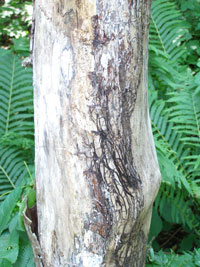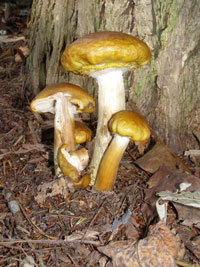Quick facts
- Armillaria root rot causes poor growth, yellow to brown foliage, and eventual death of the tree.
- Armillaria root rot can infect many deciduous and evergreen trees and shrubs.
- Trees infected with Armillaria root rot have decayed roots and lower trunk. These trees often break or fall over in storms.
- A tree care professional should inspect trees with Armillaria root rot to determine if the tree is a hazard.
How to identify Armillaria root rot?
Trees infected with Armillaria:
- Experience poor growth.
- Have small or yellow leaves on deciduous trees.
- Have browning needles on evergreens.
- Have dead branches in the upper canopy.
- May produce an abundant crop of seeds or cones.
- Eventually die.
Clusters of honey-colored mushrooms may grow at the base of the tree in fall.
- Flat, white sheets of fungal growth can be found between the bark and the wood at the base of infected trees.
- Thick, black, shoestring-like, fungal strands sometimes grow in a net on infected trees and in the soil around the tree base.
- In pine, spruce or other evergreen trees, the tree base just below the soil surface may be encrusted in resin.
- Infected wood becomes white, soft and stringy. This decay may extend from the tree base up to 6 feet into the trunk.
- Infected trees frequently break or fall over in storms.
How does Armillaria survive and spread?
A variety of Armillaria fungi can cause Armillaria root rot. Disease can occur in many different evergreen and deciduous trees and shrubs.
Armillaria can survive many years in wood debris like an old stump or root system. New infections occur when healthy roots grow close to diseased roots. Black shoestring-like strands of fungal growth, called rhizomorphs, can spread up to 10 feet from an infected tree or stump to infect healthy roots.
Once inside, the fungus colonizes the roots and trunk base. This causes the wood to decay. A vigorous tree can often slow the growth of the fungus, but stressed trees are usually damaged very quickly.
Trees die of Armillaria root rot when:
- The infection girdles the base of the trunk.
- The trees fall over due to loss of roots.
- The weakened trunks break.
How to manage Armillaria root rot
Reduce stress on trees
- Mulch the soil around the base of the tree.
- Water trees during drought.
- Protect trees from wounding. Do not injure trees with lawnmowers, weed whips or other large equipment.
Protect people and property
- Have infected trees assessed by a certified arborist to determine their structural stability.
- Remove unstable trees to prevent damage caused by falling trees.
Remove all wood infected with Armillaria
- Remove the stumps and as many roots as possible of infected trees.
Reviewed in 2024




